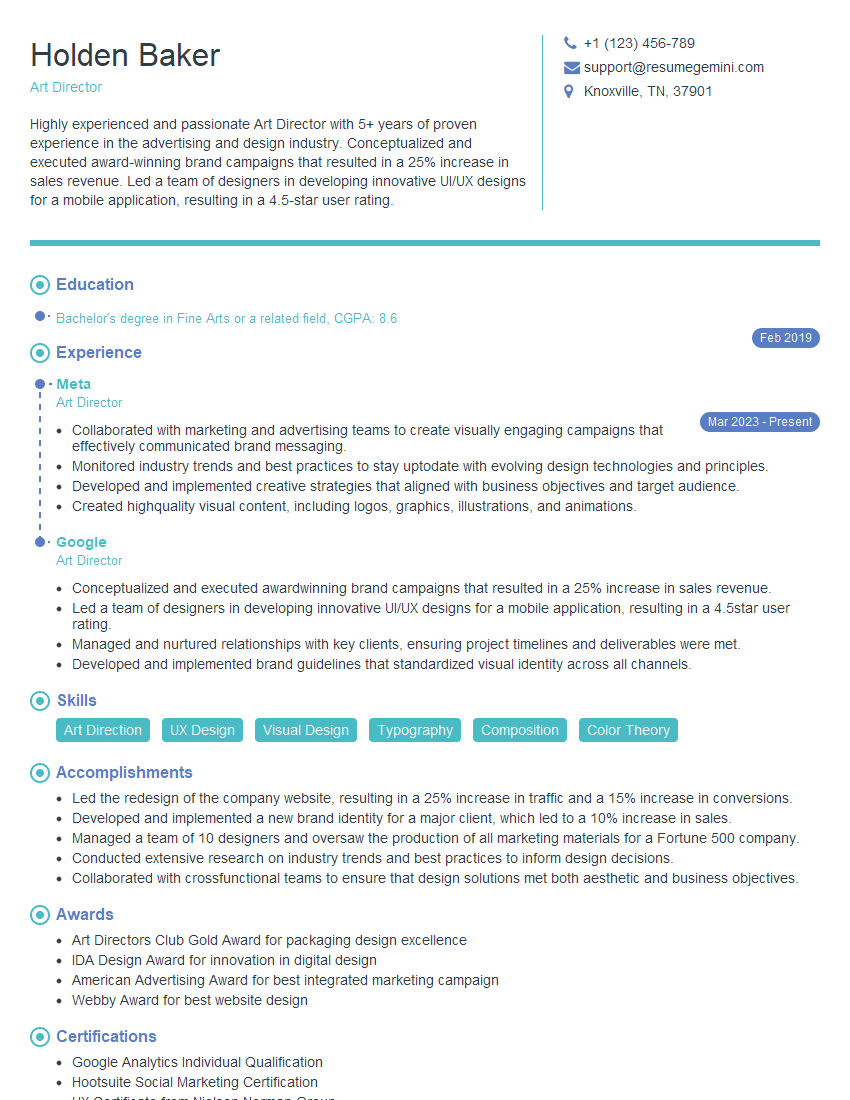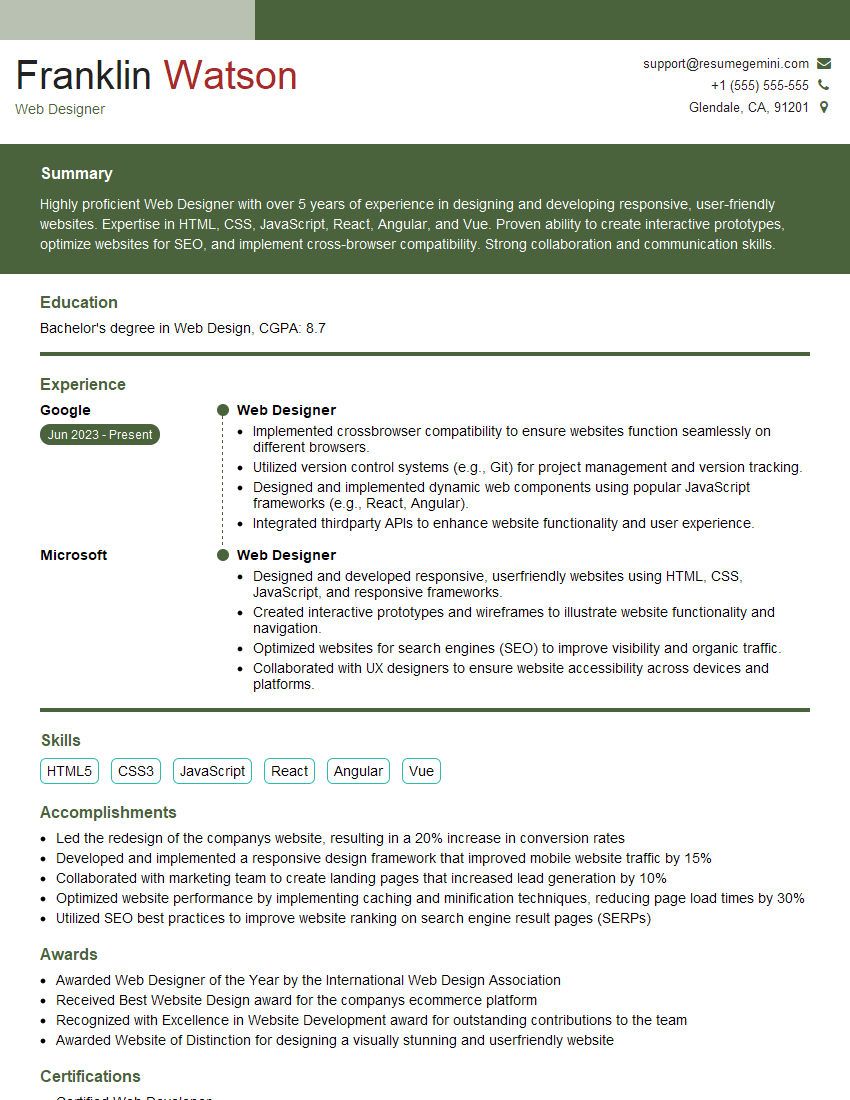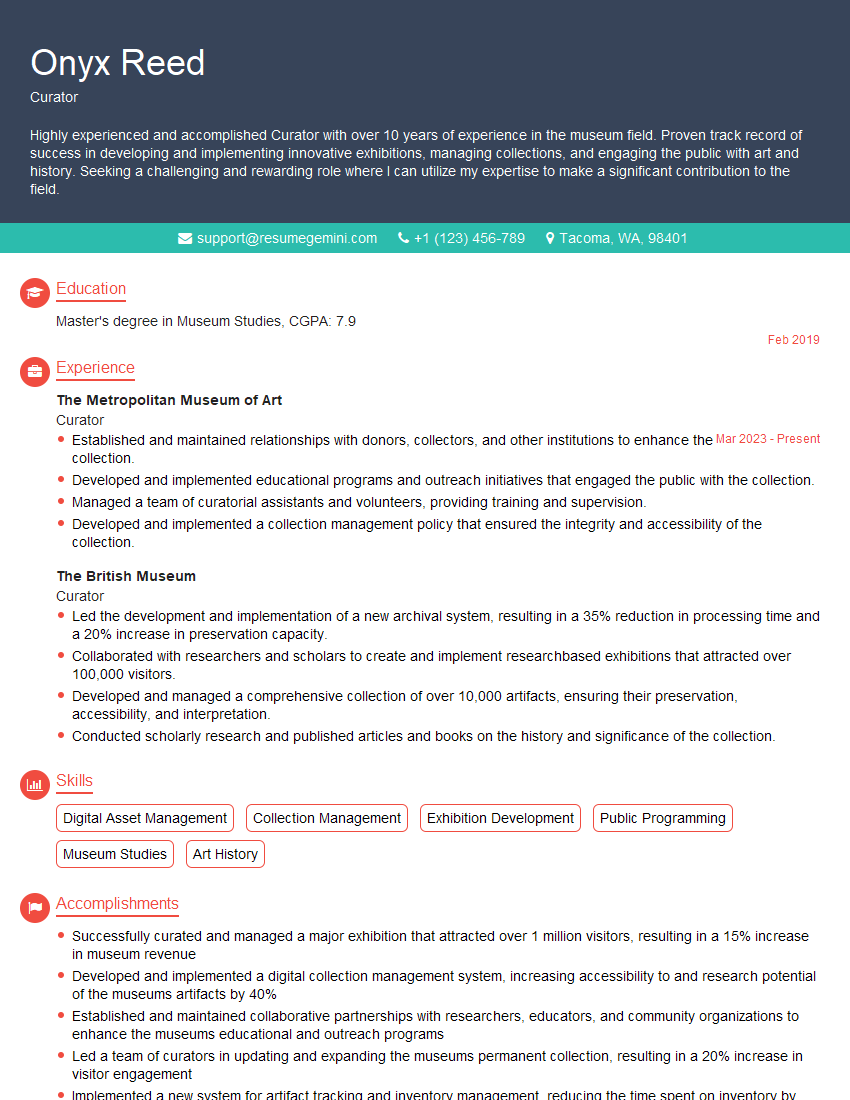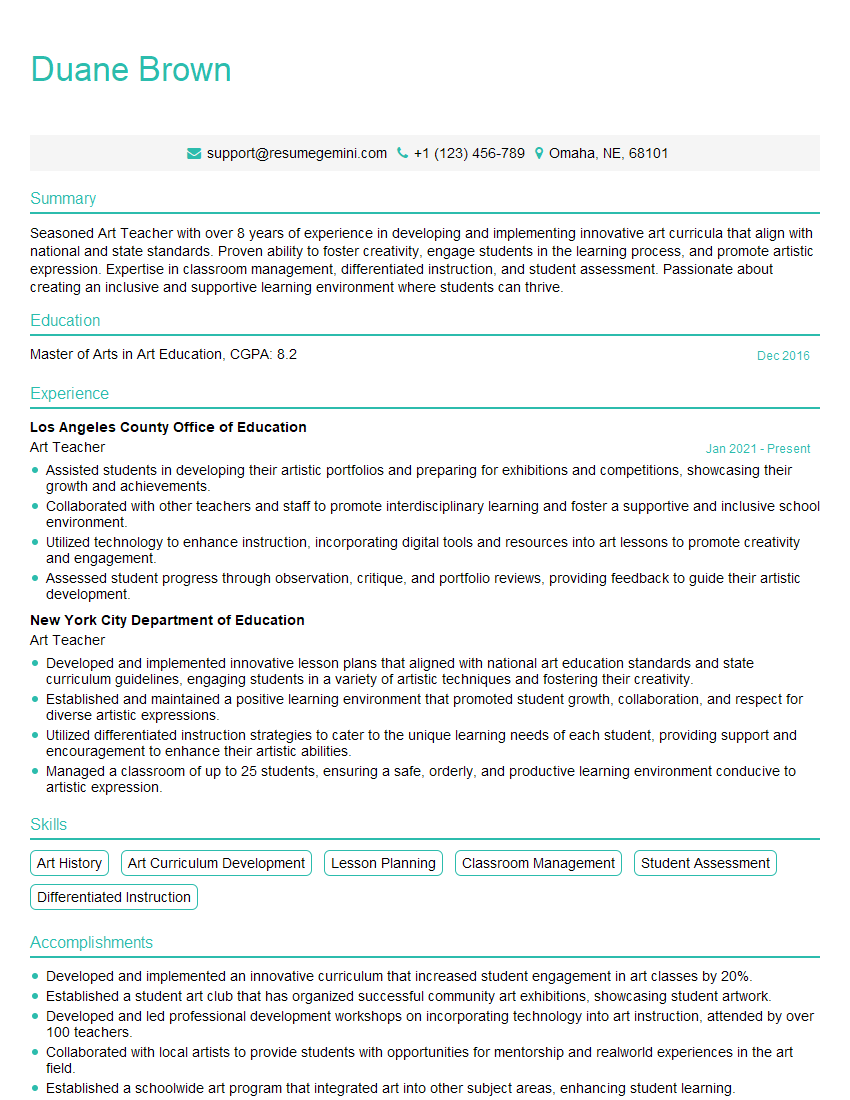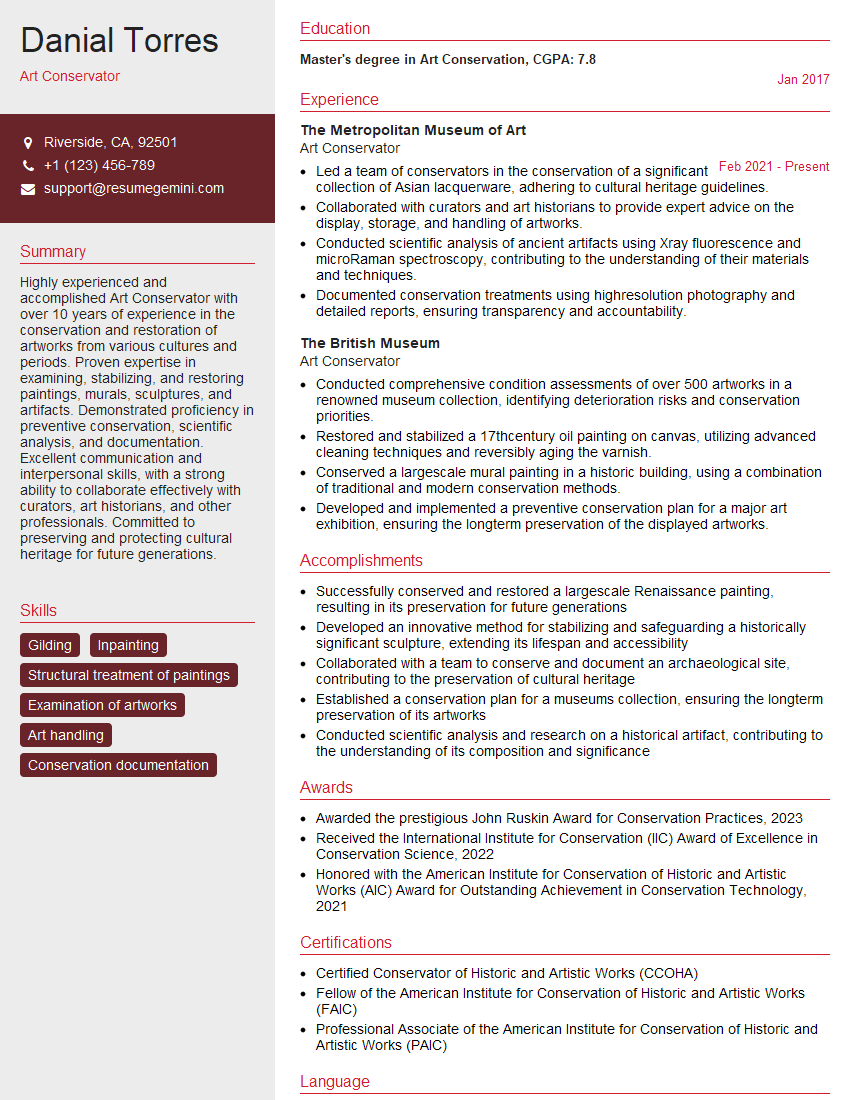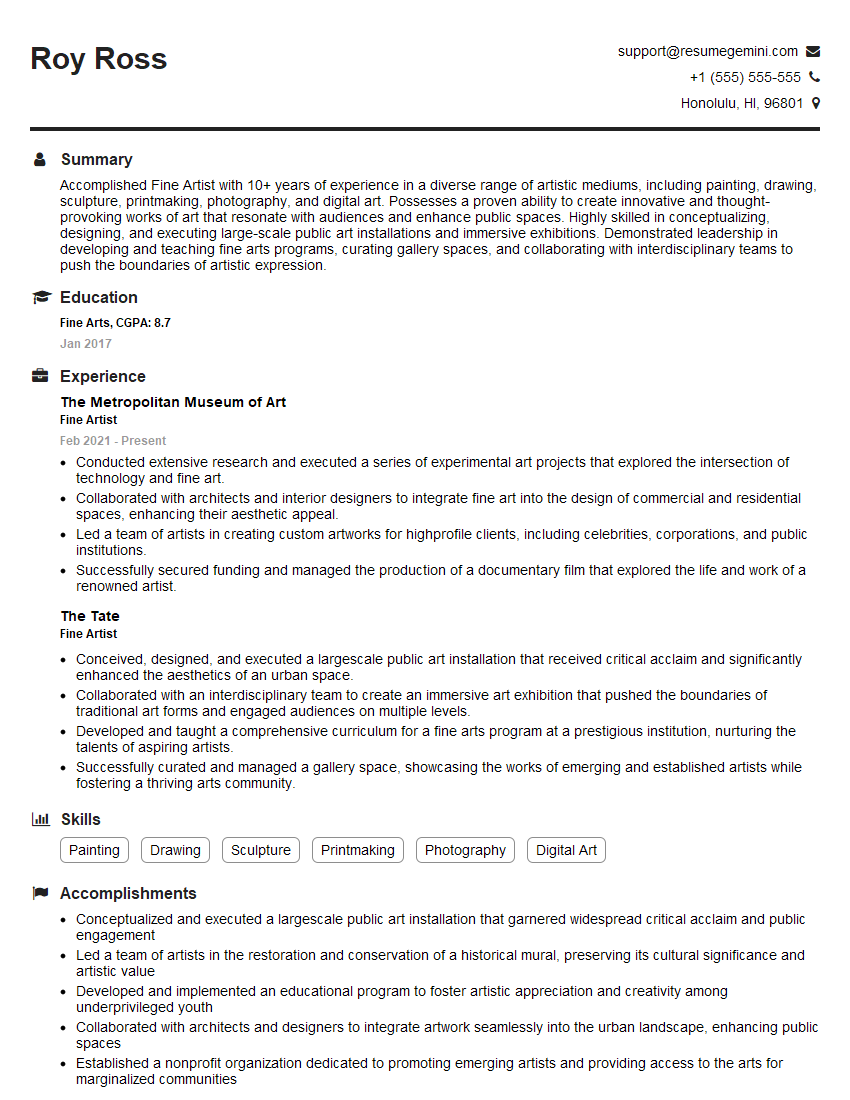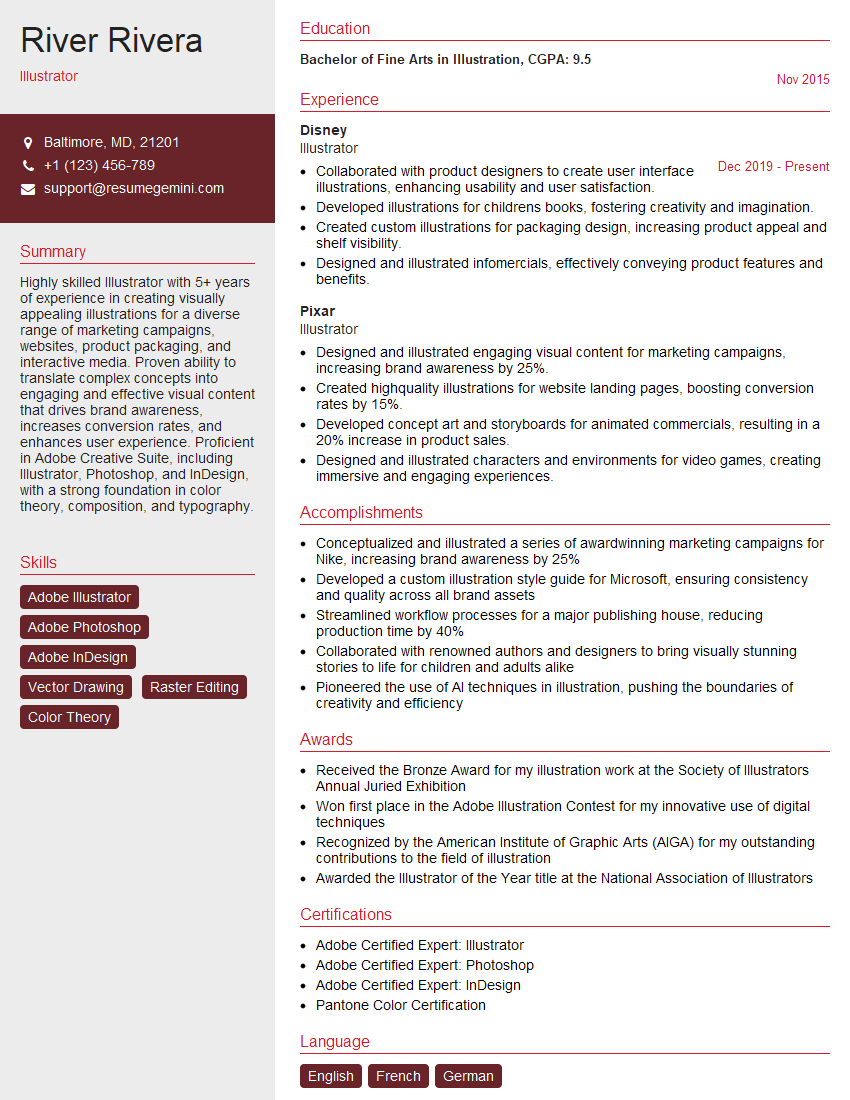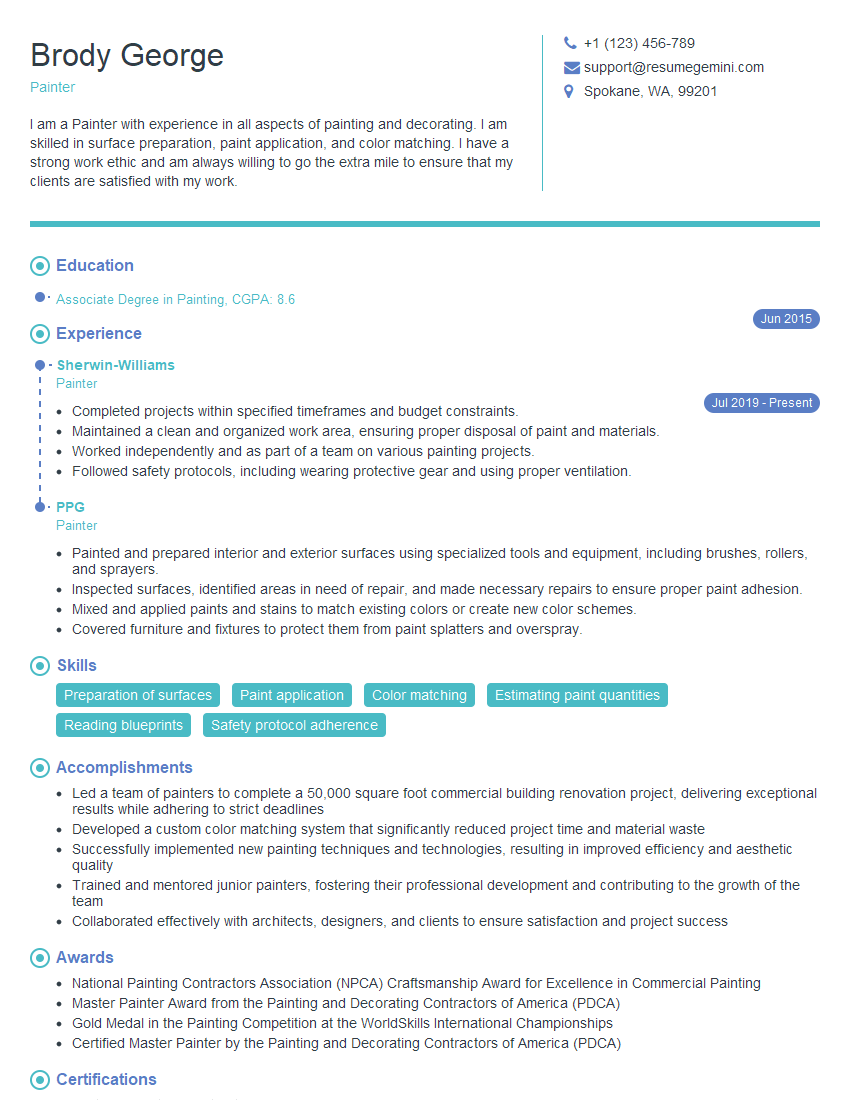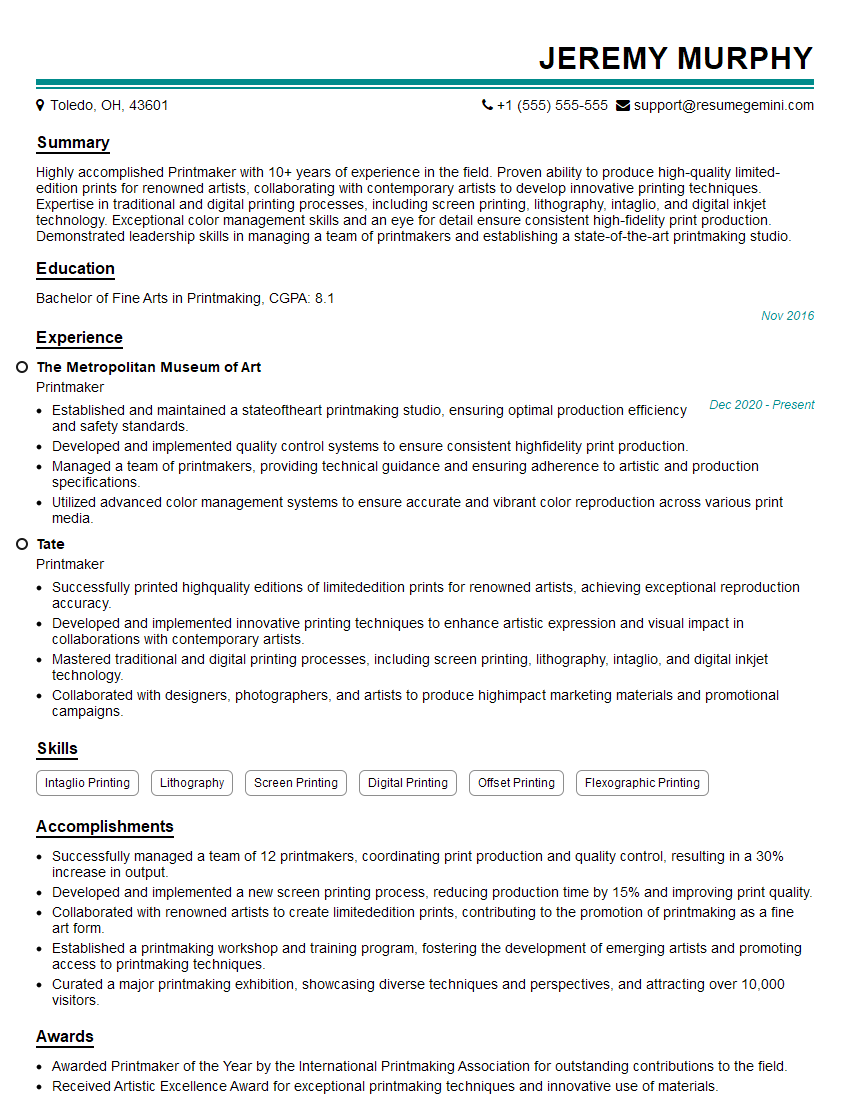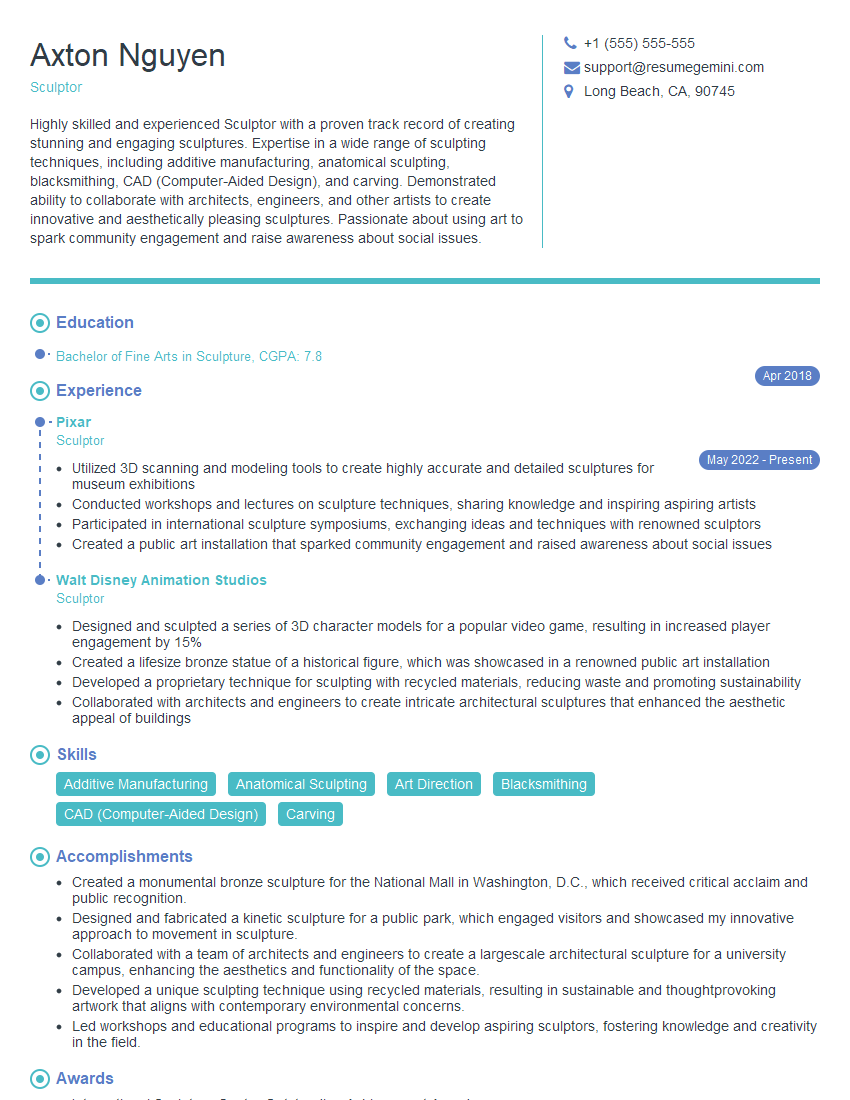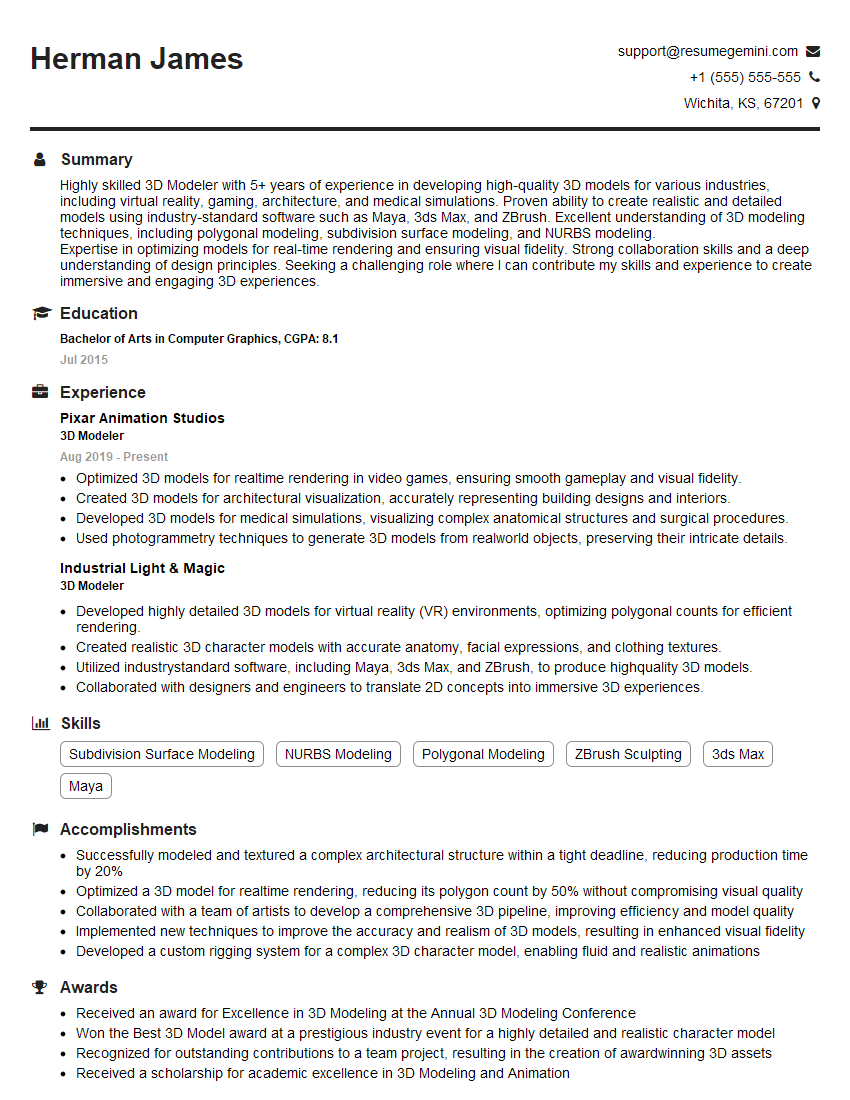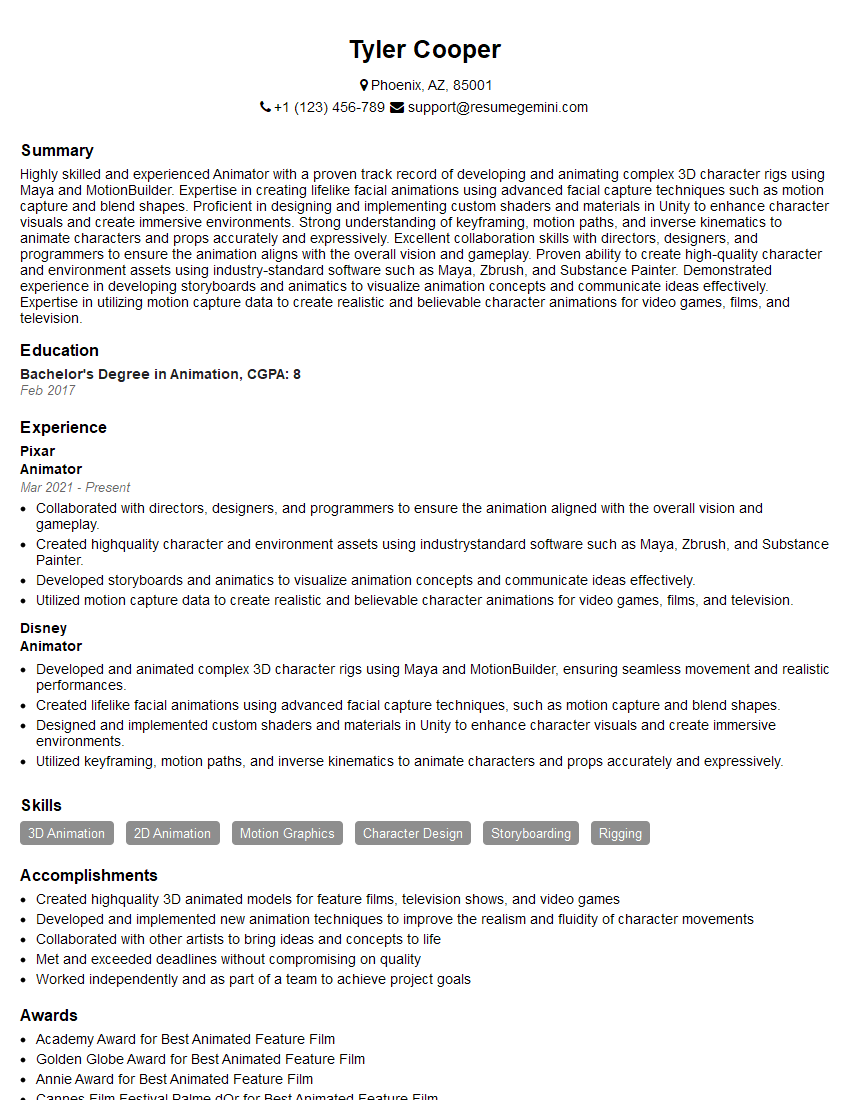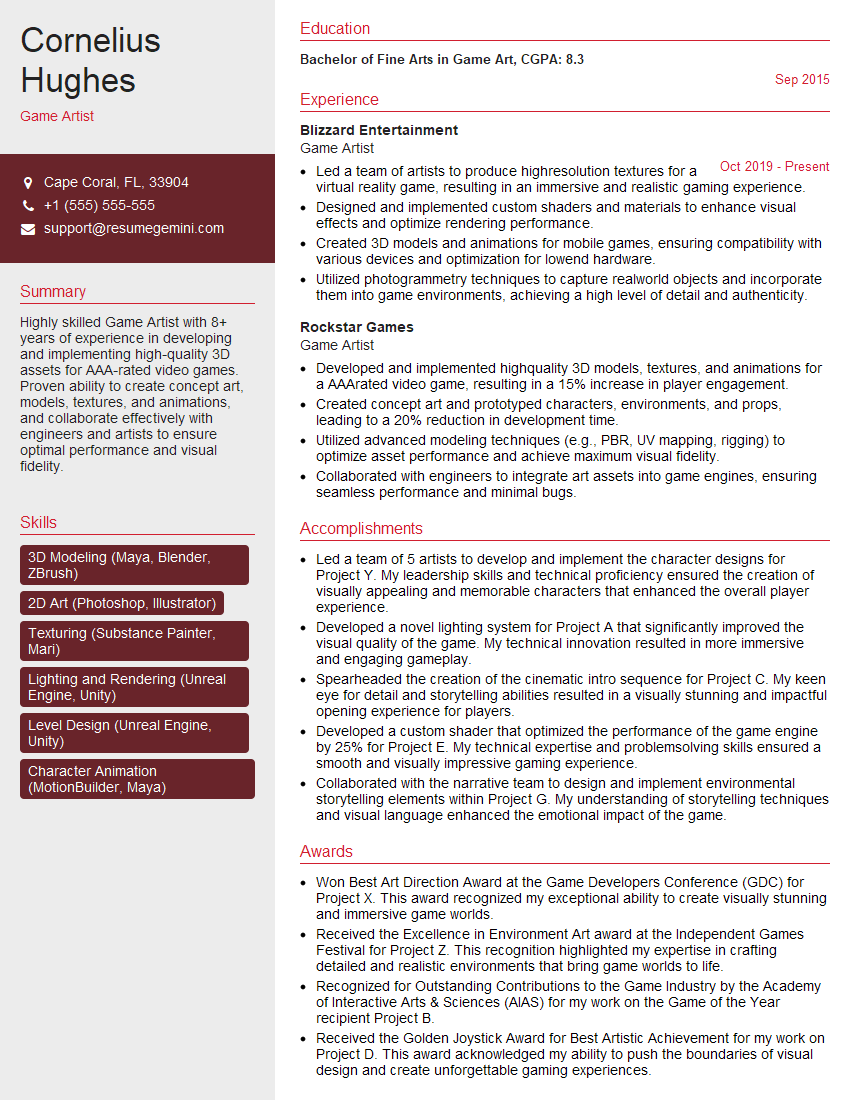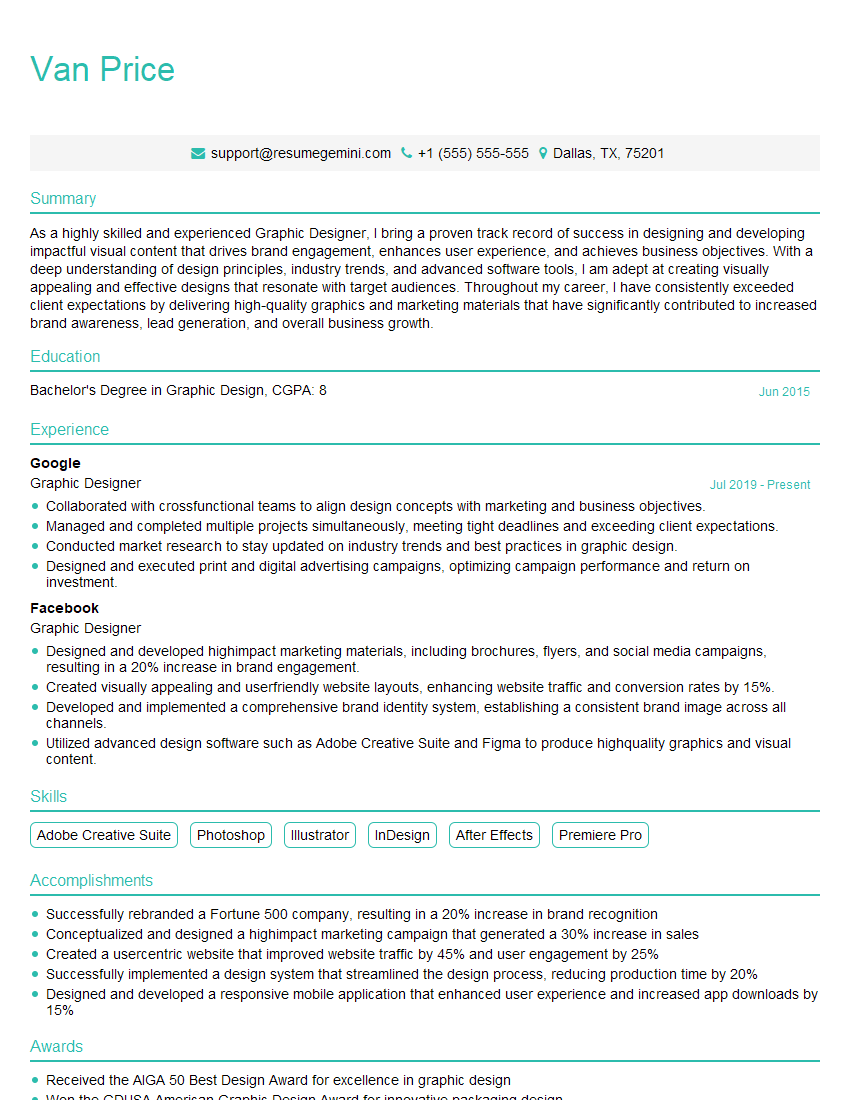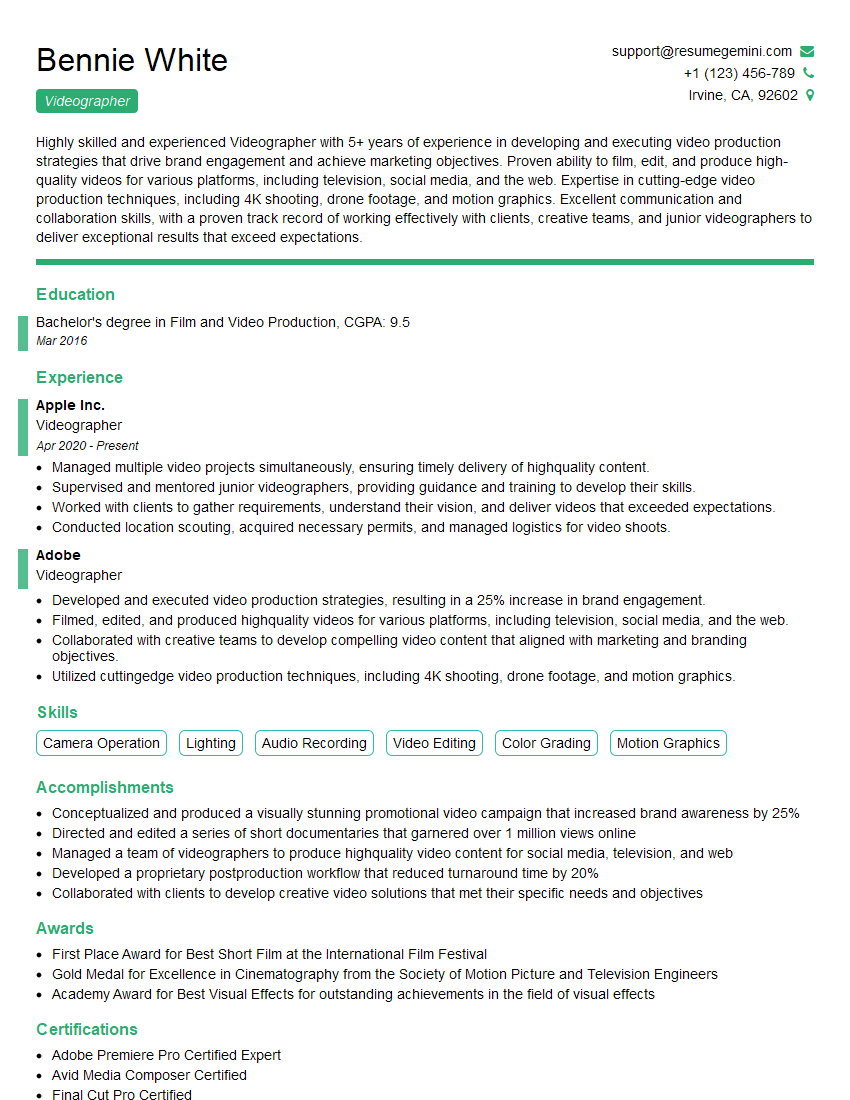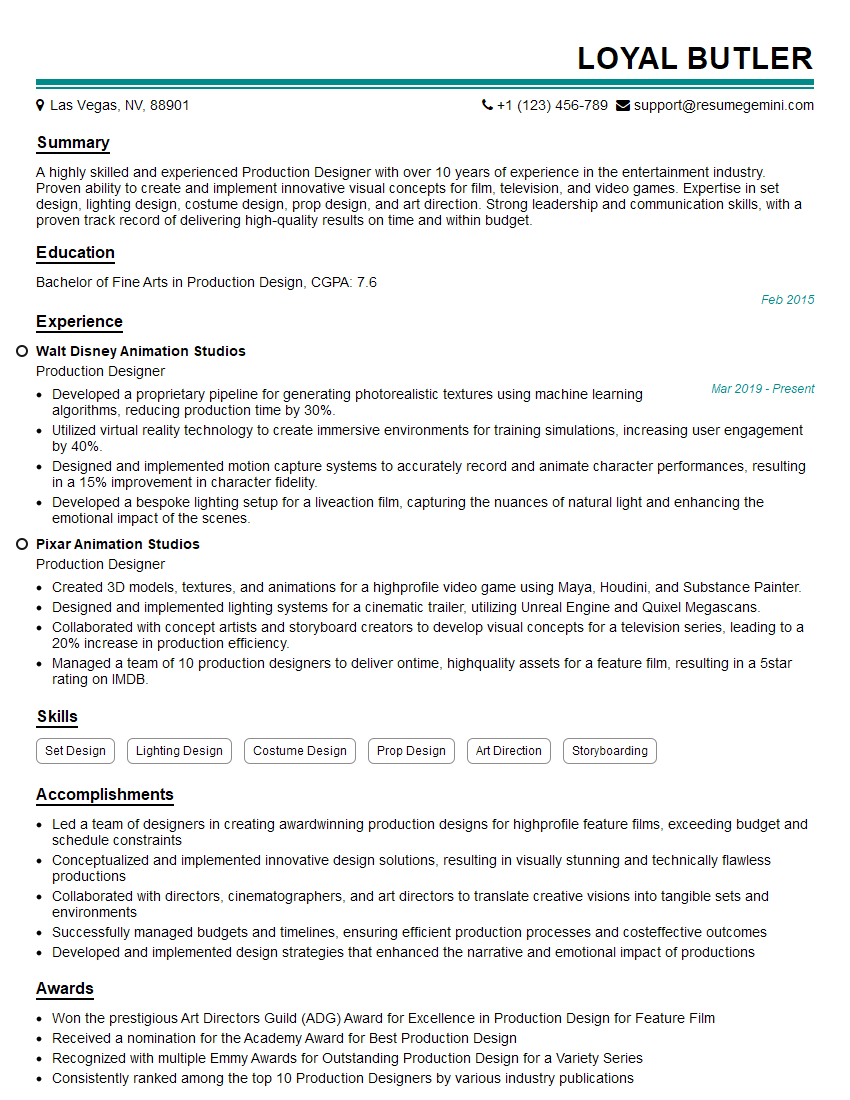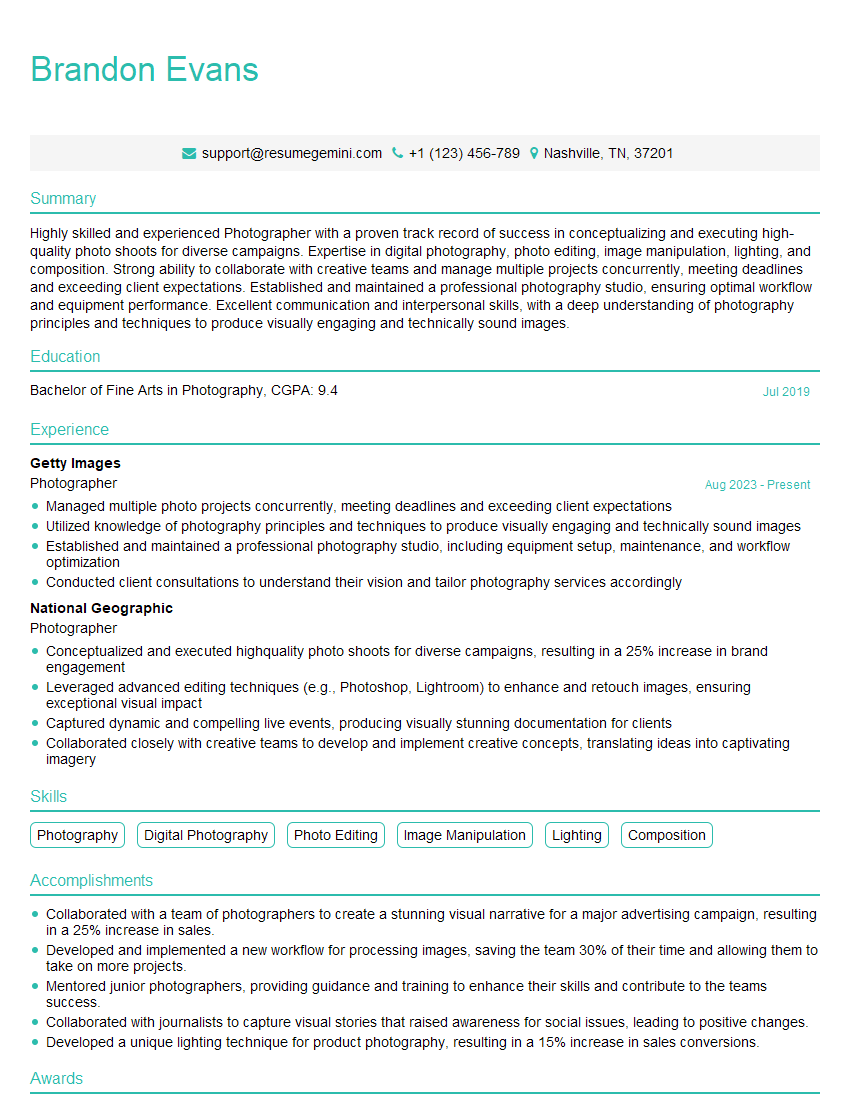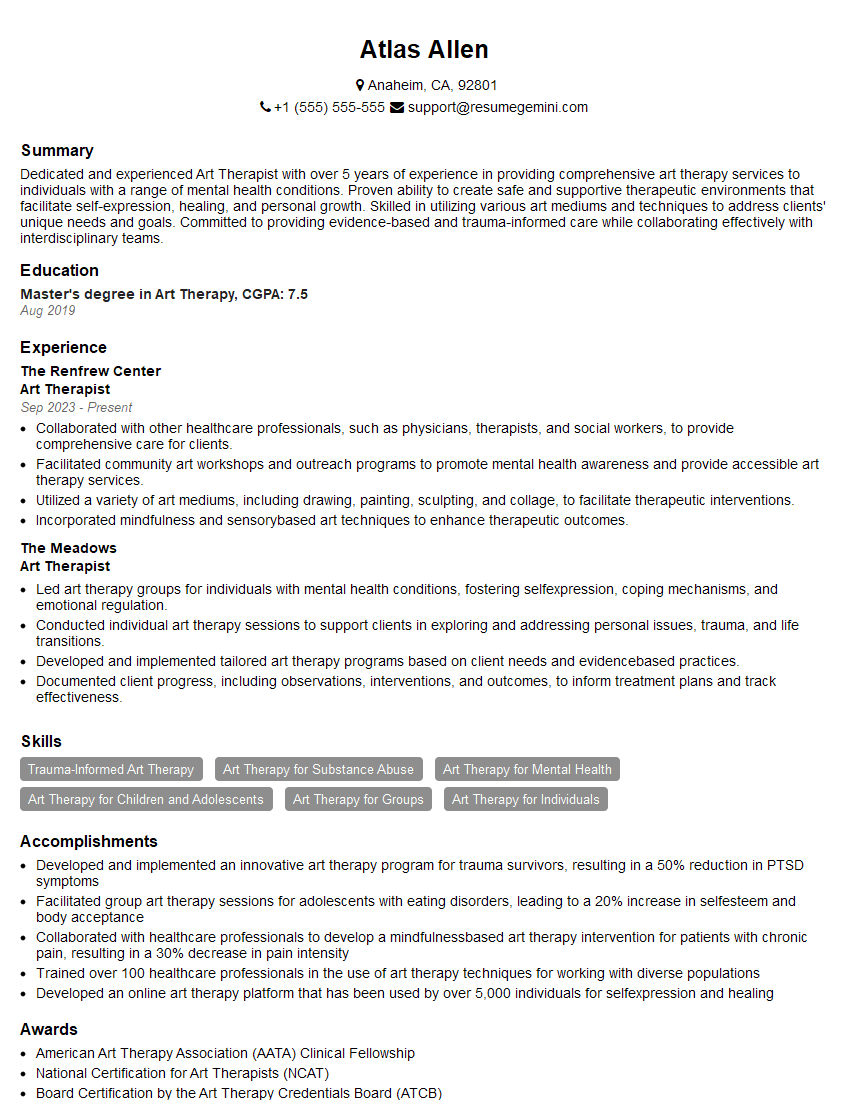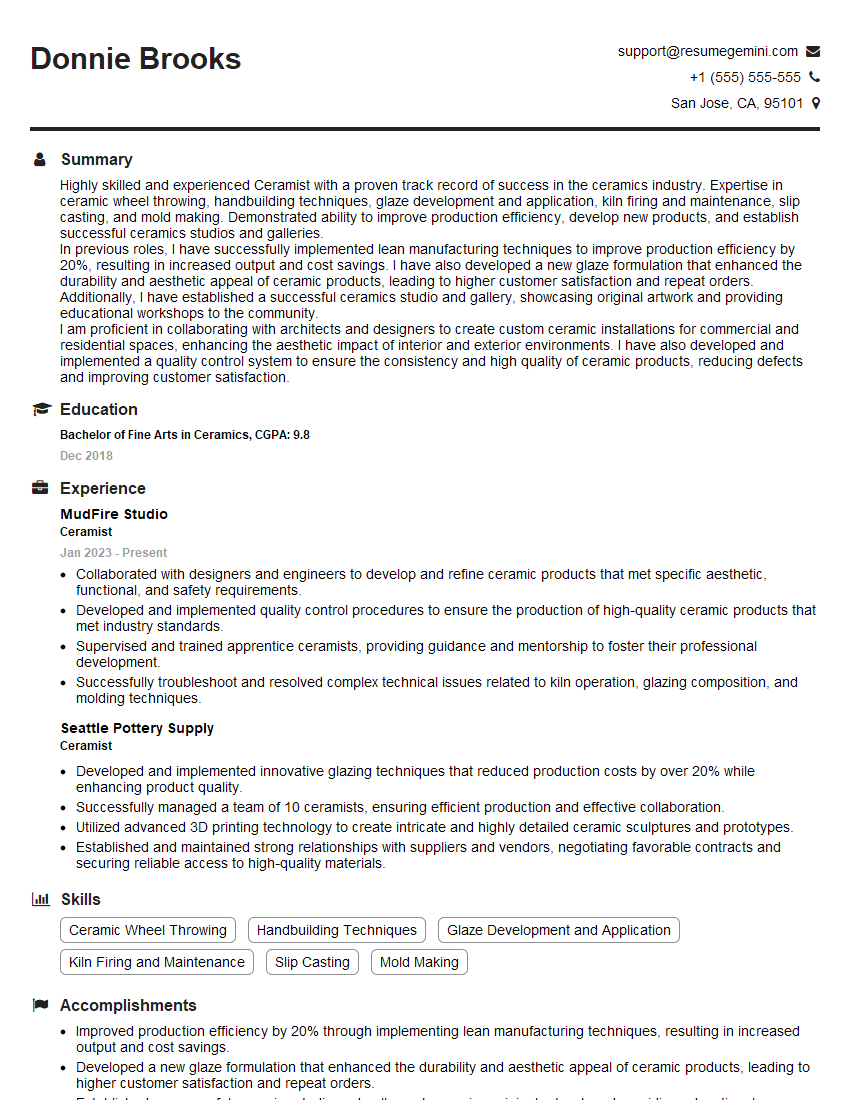Unlock your full potential by mastering the most common Artistic Expression interview questions. This blog offers a deep dive into the critical topics, ensuring you’re not only prepared to answer but to excel. With these insights, you’ll approach your interview with clarity and confidence.
Questions Asked in Artistic Expression Interview
Q 1. Describe your artistic process from concept to completion.
My artistic process is iterative and deeply personal, but generally follows a structured path from initial concept to final piece. It begins with inspiration – this could be anything from a vivid dream to a social issue, a piece of music, or even a fleeting emotion. I then spend time brainstorming and sketching, exploring different visual representations of my concept. This phase involves a lot of experimentation; I might try different compositions, perspectives, and styles. Next comes the development phase, where I refine my chosen sketch, paying close attention to detail and exploring different techniques. This involves selecting the appropriate medium, ensuring the color palette aligns with my vision, and experimenting with texture and form. The execution phase is where I bring the piece to life using my chosen medium. Finally, there’s the reflection and refinement phase, where I step back and assess the finished piece, making any necessary adjustments before declaring it complete. This process is not linear; I might jump between phases, returning to earlier stages for refinement or adjustments.
Q 2. Explain your understanding of color theory and its application in your work.
Color theory is fundamental to my artistic practice. I understand the color wheel – the relationship between primary, secondary, and tertiary colors – and how these relationships influence mood and visual impact. For example, warm colors (reds, oranges, yellows) evoke feelings of energy and excitement, while cool colors (blues, greens, purples) often create a sense of calm or serenity. I use complementary colors (colors opposite each other on the wheel) to create contrast and vibrancy, while analogous colors (colors next to each other on the wheel) provide harmony and a sense of unity. Hue, saturation, and value (the lightness or darkness of a color) are also crucial elements I manipulate to achieve specific effects. In one project, I used a predominantly cool palette to convey a feeling of isolation, contrasting it with small bursts of warm color to highlight specific elements of the composition. Understanding these principles allows me to communicate my intended message and emotion effectively.
Q 3. How do you incorporate feedback into your creative process?
Feedback is an invaluable part of my creative process. I actively seek constructive criticism from trusted colleagues, mentors, and even potential audiences. I find it helpful to present my work at various stages of completion – from early sketches to near-final pieces – to gather diverse perspectives. I try to be open-minded and approach feedback with the goal of learning and improving, not as a personal attack. I find it beneficial to ask specific questions about what aspects resonated or didn’t, what could be improved, and what alternative interpretations are possible. The key is to distinguish between subjective opinions and objective observations, which helps me understand where adjustments are genuinely needed. This approach has been vital in improving my ability to tailor my work to specific audiences and contexts.
Q 4. Discuss your experience with different artistic mediums and techniques.
My artistic experience spans a variety of mediums and techniques. I’m proficient in traditional techniques like painting (oil, acrylic, watercolor), drawing (pencil, charcoal, pastel), and printmaking (etching, linocut). I also have extensive experience in digital art, utilizing software like Photoshop and Illustrator to create both 2D and 3D artwork. Each medium presents its unique challenges and rewards; for example, the spontaneity of watercolor versus the meticulous layering of oil paint, or the precise control of digital tools versus the tactile experience of sculpting clay. Experimenting with diverse techniques keeps my practice fresh, expands my artistic vocabulary, and allows me to explore different aesthetic effects.
Q 5. What software or tools are you proficient in?
I am proficient in Adobe Creative Suite (Photoshop, Illustrator, InDesign), Procreate (iPad app), Blender (3D modeling and animation), and Cinema 4D. My familiarity with these software packages allows me to adapt quickly to different project requirements and execute my vision across a range of media. I also have some experience with video editing software like Adobe Premiere Pro and After Effects, broadening my multimedia capabilities. My technical skills are continuously evolving, as I believe staying updated with emerging technologies is important for any artist.
Q 6. Describe a project where you overcame a creative challenge.
One particularly challenging project involved creating a large-scale mural depicting a complex narrative scene. The challenge wasn’t just the size of the piece but the need to translate a detailed, multi-layered story onto a public wall. Initially, my attempts felt cluttered and confusing. To overcome this, I broke down the narrative into smaller, more manageable scenes, creating individual sketches for each. This allowed me to focus on the composition and visual flow of each section before assembling the whole piece. I also utilized digital mockups to experiment with different color palettes and compositional arrangements before transferring the final design to the wall. This methodical approach, along with receiving feedback from community members, ultimately resulted in a successful and impactful mural that effectively conveyed the intended story.
Q 7. How do you manage your time effectively when working on multiple projects?
Managing multiple projects requires a structured approach. I use a project management system that allows me to track deadlines, allocate time blocks for each project, and prioritize tasks based on urgency and importance. I find that creating detailed project plans with clear milestones helps me stay organized and focused. I also employ time-blocking techniques, scheduling specific times for each project to ensure dedicated work periods. Furthermore, I regularly review my progress and adjust my schedule as needed, acknowledging that unexpected challenges or opportunities may arise. Maintaining a healthy work-life balance is essential to avoid burnout and maintain creativity, ensuring that I can consistently produce high-quality work across my diverse projects.
Q 8. Explain your approach to collaboration within a creative team.
My approach to collaboration is built on open communication, mutual respect, and a shared vision. I believe in fostering an environment where every team member feels comfortable contributing their unique skills and perspectives. I initiate collaborative brainstorming sessions early in the project lifecycle, encouraging diverse ideas and constructive feedback. We establish clear roles and responsibilities to avoid redundancy and ensure efficient workflow. Regular check-ins and progress reviews are essential for maintaining transparency and addressing challenges promptly. For example, in a recent mural project, we used a shared online whiteboard to sketch initial designs, allowing each team member to contribute simultaneously and build upon each other’s ideas. This collaborative approach not only resulted in a more cohesive final product but also strengthened our team dynamic.
- Open Communication: Regular meetings and informal discussions to keep everyone informed and engaged.
- Shared Vision: Establishing a common goal and understanding from the outset.
- Constructive Feedback: Creating a safe space for critique and improvement.
- Clear Roles: Defining individual responsibilities to optimize efficiency.
Q 9. How do you stay current with trends and developments in the art world?
Staying current in the art world requires a multifaceted approach. I regularly visit museums and galleries, both physically and virtually, to experience diverse artistic movements and techniques firsthand. I subscribe to art magazines and online publications like Artforum and Hyperallergic, keeping abreast of exhibitions, artist profiles, and critical reviews. Following influential artists and curators on social media platforms like Instagram and Twitter allows me to discover emerging trends and participate in online discussions. Furthermore, attending conferences, workshops, and artist talks provides invaluable opportunities for networking and learning from peers and established figures in the field. For instance, my recent participation in a digital art symposium broadened my understanding of NFT technology and its implications for artistic creation and distribution.
Q 10. Describe your artistic style and influences.
My artistic style is best described as contemporary expressionism with surrealist undertones. My work often explores themes of identity, memory, and the subconscious, using vibrant colors and dynamic compositions to convey emotion and evoke a sense of wonder. My influences are diverse, ranging from the bold brushstrokes of Van Gogh to the dreamlike imagery of Dali and the social commentary of Banksy. I’m fascinated by how different artistic movements have tackled similar themes across history, and I find inspiration in the interplay between tradition and innovation. For example, I recently incorporated elements of traditional Japanese woodblock printing into a series of digital artworks, creating a unique fusion of ancient techniques and modern technology.
Q 11. What are your strengths and weaknesses as an artist?
One of my greatest strengths is my ability to conceptualize and execute ambitious projects. I’m a highly detail-oriented artist, ensuring that every element of my work is carefully considered and executed to the highest standards. I also possess strong problem-solving skills, enabling me to overcome technical challenges and adapt to unexpected circumstances. However, I recognize that perfectionism can sometimes lead to procrastination. I’m actively working on improving my time management skills and learning to prioritize tasks effectively. Another area I’m developing is expanding my skillset in different media, actively experimenting with techniques outside of my comfort zone.
Q 12. How do you handle criticism of your work?
I view criticism as an invaluable tool for growth and improvement. I believe that constructive criticism, when delivered thoughtfully, can help artists refine their vision and improve their craft. I approach criticism with an open mind, listening carefully to the feedback and considering its validity. While not all criticism is helpful or well-intentioned, I strive to identify the underlying points and use them to inform my future work. For example, criticism on a past project about the lack of clarity in my message led me to refine my approach to conceptualization and communication in my subsequent projects. Learning to separate constructive feedback from purely subjective opinions is crucial, and I’ve developed the skill to evaluate the source and intent behind the criticism offered.
Q 13. Describe your portfolio and highlight your most successful projects.
My portfolio showcases a diverse range of artwork, encompassing both digital and traditional media. It includes paintings, sculptures, digital illustrations, and installations. One of my most successful projects was a series of interactive light installations for a city-wide art festival. The installations utilized motion sensors and responsive lighting to create an immersive and engaging experience for viewers, resulting in widespread media coverage and critical acclaim. Another successful project was a collaborative mural project that addressed issues of environmental sustainability in my local community. This project highlighted my ability to work effectively within a team to achieve a shared artistic vision.
Q 14. Explain the conceptual underpinnings of a specific artwork in your portfolio.
One artwork in my portfolio, titled “Ephemeral Echoes,” is a mixed-media piece exploring the fleeting nature of memory and the passage of time. It combines elements of painting, collage, and digital manipulation to create a layered and complex image. The central image is a distorted portrait, partially obscured by layers of translucent textures and fragmented memories. These fragmented elements represent the way memories become distorted and lost over time, symbolized through the partially visible and hidden details within the work. The use of muted colors and a somewhat melancholic palette further enhances this sense of fading memories and the bittersweet acknowledgment of what was once present. The overall effect is one that invites introspection and contemplation on the human experience of time and remembrance.
Q 15. How do you adapt your artistic style to meet the needs of different clients or projects?
Adapting my artistic style to meet diverse client needs and project requirements is crucial. It’s not about compromising my artistic integrity but rather about understanding the project’s goals and translating them into a visually compelling and effective piece. I begin by engaging in thorough discussions with clients, understanding their vision, target audience, and the intended impact of the artwork. This involves actively listening and asking clarifying questions to uncover any hidden preferences or constraints. For example, a client might need a logo design for a tech startup – in this case, I’d likely favor a minimalist, modern aesthetic using bold geometric shapes and clean lines, as opposed to a more ornate style suitable for a luxury brand. I present mood boards and sketches to show possible directions, ensuring alignment before committing to a particular style.
Once the core style is agreed upon, I further refine it based on practical considerations like the medium (digital, print, physical sculpture etc.), budget, and deadlines. My ability to adapt seamlessly across mediums is a key strength; I can just as easily create a vibrant watercolor painting as a sophisticated digital animation. This adaptability is a critical component of successful collaboration and the effective delivery of desired results.
Career Expert Tips:
- Ace those interviews! Prepare effectively by reviewing the Top 50 Most Common Interview Questions on ResumeGemini.
- Navigate your job search with confidence! Explore a wide range of Career Tips on ResumeGemini. Learn about common challenges and recommendations to overcome them.
- Craft the perfect resume! Master the Art of Resume Writing with ResumeGemini’s guide. Showcase your unique qualifications and achievements effectively.
- Don’t miss out on holiday savings! Build your dream resume with ResumeGemini’s ATS optimized templates.
Q 16. Describe your experience with specific design principles (e.g., Gestalt principles).
Gestalt principles are fundamental to my design process. These principles, focusing on how humans visually perceive and organize information, guide my choices in composition, layout, and overall visual impact. I frequently utilize principles like:
- Proximity: Grouping related elements closely together to create visual unity. For instance, in a website design, I’d place navigation links near each other to improve usability.
- Similarity: Using consistent visual elements (color, shape, size) to show relationships between items. This can help unify different parts of a complex illustration.
- Closure: Using incomplete shapes to create the perception of a whole. This is a powerful technique for creating intrigue and memorability.
- Continuity: Guiding the viewer’s eye through the artwork with smooth lines and paths. A strong example is creating a sense of movement in a graphic design by leading lines.
- Figure/Ground: Differentiating the main focus (figure) from the background (ground). This helps to create clear hierarchy and avoid visual clutter.
Understanding these principles allows me to create visually pleasing and easy-to-understand artwork. It ensures the artwork effectively communicates its message and provides a positive user experience. For instance, in a poster design, I’d use proximity to group related text and images, similarity to establish visual consistency, and figure/ground to clearly highlight the main message.
Q 17. How do you ensure the accessibility of your artwork?
Accessibility in artwork is paramount, ensuring that it’s enjoyable and understandable by everyone. My approach considers various disabilities, and it starts with thoughtful design choices from the outset, not as an afterthought. This includes:
- Color Contrast: Ensuring sufficient contrast between text and background colors to improve readability for individuals with low vision. I use tools to check color contrast ratios (WCAG guidelines are my benchmark).
- Alternative Text (Alt Text): For digital artwork, providing detailed alt text for images ensures that screen readers can accurately describe the image to visually impaired users. I’m very meticulous in crafting descriptive alt text.
- Font Selection: Choosing clear, legible fonts is critical, avoiding overly stylized or decorative fonts that can be hard to read.
- Simplicity: Avoiding overly complex designs that can be confusing or overwhelming for some viewers.
- Captioning and Transcripts: For videos or animations, accurate captions and transcripts are provided to ensure accessibility for the hearing-impaired.
By prioritizing accessibility, I broaden the reach and impact of my artwork, ensuring it’s inclusive and appreciated by a wider audience.
Q 18. What is your understanding of copyright and intellectual property?
Copyright and intellectual property are critical to my practice. I understand that copyright protects original creative works, including visual art, from unauthorized use. This protection extends to the expression of an idea, not the idea itself. I always retain copyright for my work unless explicitly transferring it to a client through a written agreement. These agreements clearly outline the scope of the license granted (exclusive or non-exclusive) and the permitted uses of the artwork. This is vital for both protection and preventing misunderstandings. I am also aware of fair use principles, which allows for limited use of copyrighted material under specific circumstances, such as criticism, commentary, news reporting, teaching, scholarship, or research.
For client projects, I always make sure to acquire necessary licenses for any third-party assets (images, fonts, music) used in my artwork, ensuring I am not violating any existing copyrights. Understanding the intricacies of intellectual property ensures I work legally and ethically, protecting both my own rights and respecting the rights of others.
Q 19. How do you balance artistic vision with practical constraints?
Balancing artistic vision with practical constraints is a constant negotiation in my work. My creative vision is paramount, but it must be achievable within the given parameters of a project. I address this challenge through iterative design, beginning with a conceptual exploration that allows for unfettered creativity. Once a strong artistic vision has solidified, I then consider the practical constraints: budget, time limitations, technical feasibility, and client expectations. This may involve adjustments to the scale, materials, or techniques, but always with the intent of preserving the core artistic integrity of the piece.
For example, I might initially envision a large-scale oil painting for a client but, after considering the budget, we might opt for a smaller-scale print or even a digital piece that emulates the oil painting’s texture and style. It is about finding creative solutions that stay true to the artistic intent while aligning with the realities of the project.
Q 20. Explain your approach to problem-solving in a creative context.
My approach to problem-solving in a creative context is iterative and experimental. I embrace challenges as opportunities for innovation. When faced with a creative block or a technical hurdle, I employ several strategies:
- Brainstorming: I dedicate time to free-flowing brainstorming sessions, exploring a wide range of ideas without immediate judgment.
- Research and Inspiration: I actively research related works, explore different artistic styles, and draw inspiration from diverse sources.
- Experimentation: I experiment with different techniques, materials, and approaches, not afraid to try unconventional solutions.
- Seeking Feedback: I value external perspectives, actively seeking feedback from peers and mentors to gain new insights.
- Iteration and Refinement: I view the creative process as an iterative journey. I constantly refine and improve my work based on feedback and my own evolving understanding.
Essentially, my problem-solving process is a continuous cycle of exploration, experimentation, and refinement, resulting in innovative and effective solutions.
Q 21. Discuss your experience with client communication and management.
Client communication and management are integral to my success. I prioritize clear and consistent communication throughout the entire project lifecycle. This begins with an initial consultation to understand the client’s needs and expectations. I provide regular updates on the project’s progress, utilizing various methods like email, project management software, and video conferencing to ensure transparency. I actively solicit feedback at crucial milestones, making sure to address any concerns or questions promptly.
I actively listen to the client’s feedback but also provide my professional guidance and rationale behind my artistic decisions. This collaborative approach aims for a mutual understanding and a creative product that fulfills both the client’s vision and artistic excellence. Managing expectations is critical; I proactively explain the creative process, including the possibility of iterations and adjustments throughout the project. By fostering open communication and a collaborative spirit, I build strong relationships with clients and ensure successful project outcomes. I always aim for a positive and productive working environment.
Q 22. How do you measure the success of your artistic endeavors?
Measuring the success of artistic endeavors isn’t solely about sales or awards; it’s a multifaceted process. It involves a combination of objective and subjective measures. Objectively, I look at things like exhibition opportunities, sales figures, and critical reviews. These provide quantifiable data that reflects the market’s reception to my work. However, subjective measures are equally important. Did I achieve the artistic vision I set out for a piece? Did the work evoke the emotions or ideas I intended? Did it challenge me creatively and push my boundaries? These internal assessments are crucial. For example, a painting might not sell well but could be deeply satisfying because it represented a significant breakthrough in my technique or exploration of a theme. Ultimately, success is a balance of external validation and internal fulfillment.
Q 23. Describe your experience with project planning and execution.
Project planning is fundamental to my artistic practice. It begins with a clear concept: a detailed sketch, a mood board, or a written description of the desired outcome. This is followed by material sourcing – selecting the right paints, canvas, sculpting materials, or digital tools. Next, I establish a realistic timeline, breaking down the project into manageable stages. For instance, with a large sculpture, I might plan individual weeks for armature construction, clay modeling, and finishing. Execution involves meticulous record-keeping, adapting the plan as needed (artistic inspiration often leads to unplanned deviations!), and regular self-assessment to ensure I’m on track. For example, while creating a series of digital paintings, I encountered a technical issue with color grading. I solved this by dedicating a day to research and experimenting with different software settings. This flexibility and iterative approach are essential for successful project execution.
Q 24. Explain your understanding of different artistic movements or styles.
My understanding of artistic movements spans various periods and styles. I’m familiar with the classical principles of Renaissance art, emphasizing realism, balance, and harmony, exemplified by the works of Leonardo da Vinci. I’m also well-versed in Impressionism, with its emphasis on capturing light and fleeting moments, as seen in Monet’s landscapes. The bold, expressive brushstrokes of Expressionism, as demonstrated by Van Gogh, contrast sharply with the geometric abstraction of Cubism, pioneered by Picasso. I appreciate the conceptual nature of Conceptual Art, where the idea is paramount, and the Pop Art movement’s embrace of popular culture. Understanding these movements allows me to analyze and appreciate diverse artistic approaches and to draw inspiration from their strengths. This historical perspective informs my own creative choices and pushes me to explore innovative combinations of styles.
Q 25. How do you demonstrate originality in your creative work?
Originality in art isn’t about creating something completely unprecedented, but rather about expressing a unique perspective. I strive for originality by combining existing elements in novel ways, exploring uncharted territories within my chosen medium, and infusing my work with personal experiences and emotions. For example, I might combine traditional watercolor techniques with digital manipulation to create a unique texture and style. My originality doesn’t lie in inventing a new medium, but in utilizing existing ones in a way that reflects my own unique voice and perspective. Furthermore, I draw inspiration from a wide range of sources – nature, music, literature, and personal experiences – but always strive to filter these inputs through my own creative lens, resulting in a unique artistic expression.
Q 26. How do you use technology to enhance your artistic process?
Technology significantly enhances my artistic process. Digital painting software allows for experimentation and easy corrections. I use 3D modeling software for creating sculptures and installations. Furthermore, social media platforms are invaluable for networking, showcasing my work, and receiving feedback. Specific software examples include Adobe Photoshop for image manipulation, Blender for 3D modeling, and Procreate for digital painting on tablets. These technologies not only improve efficiency but also open up avenues for artistic exploration that were previously unimaginable. For instance, I can use digital tools to create complex textures and patterns, or seamlessly combine traditional and digital elements in a mixed-media approach. Technology isn’t replacing traditional methods; it’s augmenting them, pushing the boundaries of artistic possibility.
Q 27. What is your long-term career vision as an artist?
My long-term vision is to establish myself as a respected and influential artist, known for my unique style and contributions to the art world. I envision exhibiting my work nationally and internationally, collaborating with other artists and designers, and perhaps even teaching and mentoring emerging artists. I aspire to use my art to inspire, provoke thought, and connect with audiences on an emotional level. Beyond individual recognition, I hope to contribute meaningfully to the broader artistic community, nurturing creativity and furthering artistic discourse.
Q 28. Describe a time you had to make a difficult artistic decision.
During the creation of a large-scale mural, I faced a difficult decision regarding color palette. My initial concept relied heavily on vibrant, contrasting colors. However, after completing a significant portion of the work, I realized the overall effect was jarring and overwhelmed the viewer. This required a difficult decision: to either significantly rework the already completed sections or compromise my original vision. I opted for the latter, opting for a more subdued and harmonious palette, while retaining some key elements of my original idea. This involved repainting parts of the mural, which was time-consuming but resulted in a far more cohesive and impactful final piece. This experience taught me the importance of continuous evaluation and adaptability during the creative process. Sometimes, stepping back and re-evaluating your work, even if it means altering initial plans, is essential for achieving the best possible outcome.
Key Topics to Learn for Artistic Expression Interview
- Understanding Artistic Movements and Styles: Explore the historical context and key characteristics of various artistic movements (e.g., Impressionism, Surrealism, Minimalism) and their impact on contemporary art.
- Technical Proficiency and Skill Application: Demonstrate your mastery of relevant artistic techniques (e.g., painting, sculpting, digital art, photography) and your ability to apply them effectively in different contexts.
- Art Theory and Criticism: Familiarize yourself with core art theoretical concepts and be prepared to discuss and analyze artwork from various perspectives. Consider the role of aesthetics, semiotics, and cultural context in your artistic practice.
- Portfolio Development and Presentation: Understand the principles of creating a compelling and professional artistic portfolio that effectively showcases your skills and artistic vision. Practice articulating your creative process and artistic intentions.
- Creative Problem-Solving and Innovation: Be ready to discuss how you approach creative challenges, experiment with new techniques, and develop innovative solutions in your artistic work. Highlight instances where you overcame obstacles and demonstrated resilience.
- Collaboration and Communication: Discuss your experience collaborating with others (if any) and your ability to effectively communicate your artistic ideas and vision to diverse audiences.
- Adaptability and Professionalism: Demonstrate your ability to adapt to different working environments and maintain a high level of professionalism throughout the creative process.
Next Steps
Mastering artistic expression is crucial for career advancement in a competitive creative landscape. A strong understanding of art history, theory, and technical skills will set you apart. To maximize your job prospects, create an ATS-friendly resume that clearly highlights your skills and achievements. ResumeGemini is a trusted resource for building professional resumes that effectively showcase your unique artistic talents. We provide examples of resumes tailored to Artistic Expression to help guide you in crafting a compelling application. Take advantage of these resources to elevate your job search and land your dream role.
Explore more articles
Users Rating of Our Blogs
Share Your Experience
We value your feedback! Please rate our content and share your thoughts (optional).
What Readers Say About Our Blog
Hi, I’m Jay, we have a few potential clients that are interested in your services, thought you might be a good fit. I’d love to talk about the details, when do you have time to talk?
Best,
Jay
Founder | CEO
